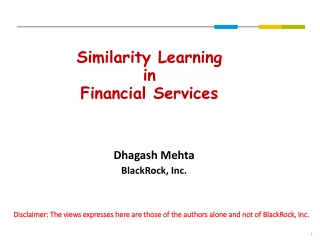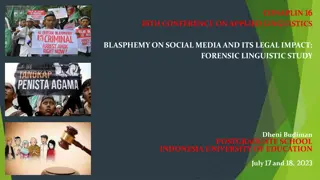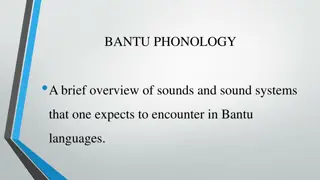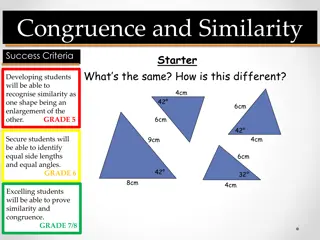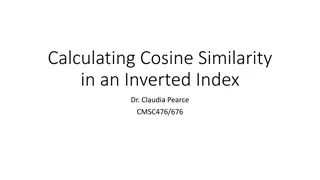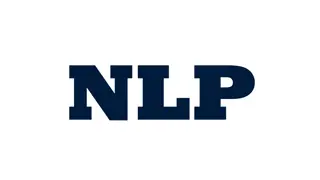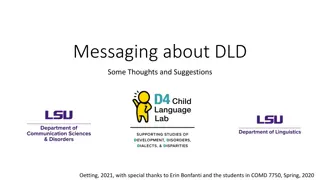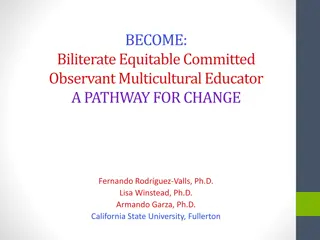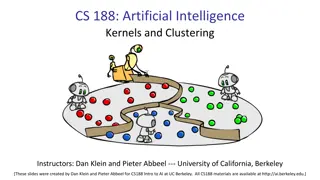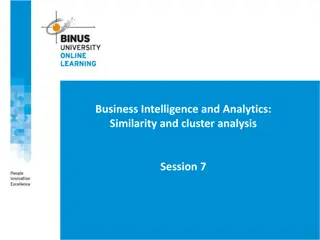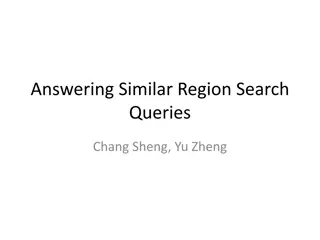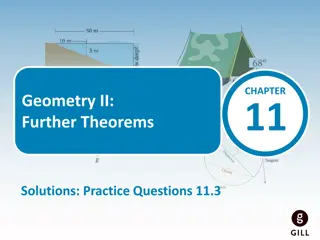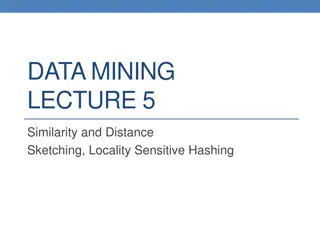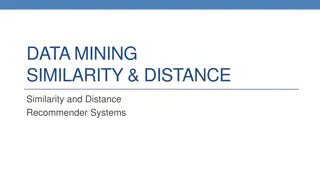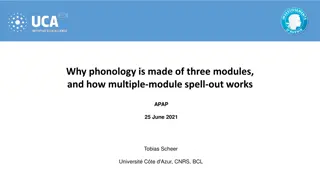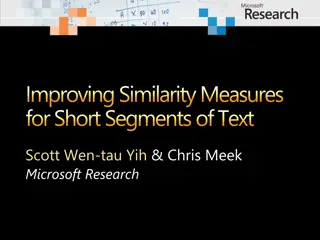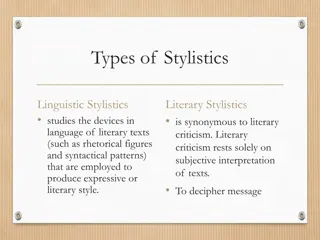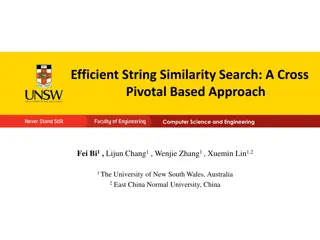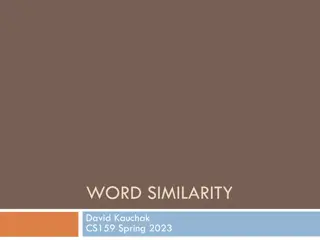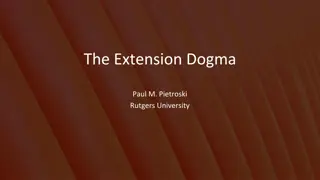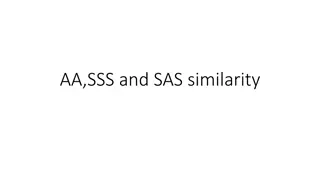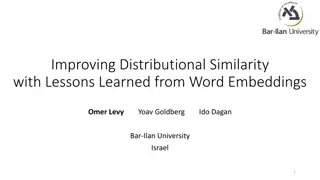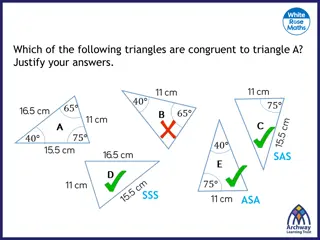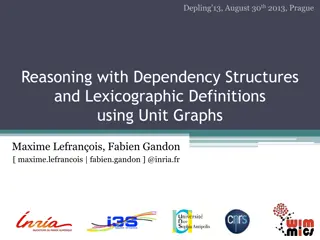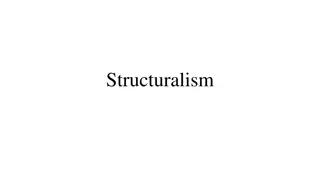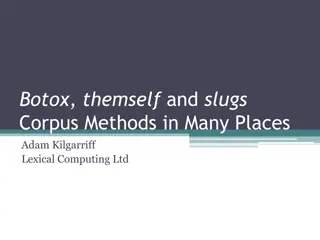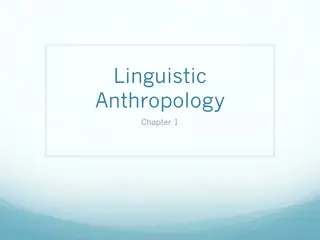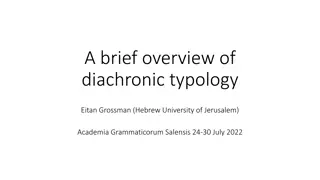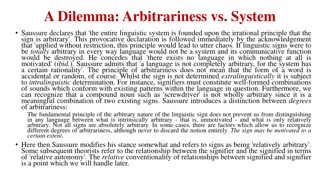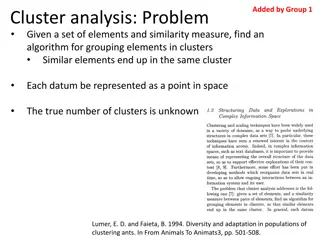Similarity Learning
Exploring the concept of similarity learning in financial services, this text delves into its applications and significance across industries. Highlighting key areas such as illiquid asset similarity and mutual fund comparison, it emphasizes the role of cognitive intelligence in recognizing similari
1 views • 26 slides
Exploring the Two Dimensions of Meaning: Similarity and Contiguity in Language and Literature
This content delves into the dimensions of meaning, focusing on similarity and contiguity, as explored in language and literature. It discusses the significance of Saussure's paradigm and syntagm, Jakobson's theories on similarity and contiguity in discourse, and the impact of brain damage on langua
1 views • 66 slides
Impact of Blasphemy on Social Media: Forensic Linguistic Analysis
Language plays a crucial role in human communication, especially on social media platforms where public speech can have legal consequences. This research delves into the concept of blasphemy on social media and its legal implications, focusing on linguistic forensic study. It explores how language c
7 views • 24 slides
Bantu Phonology and Linguistic Classification
Delve into the intriguing world of Bantu phonology and linguistic classification, covering the diverse sounds and phonological processes found in Bantu languages. Discover the rich heritage of over 500 Bantu languages in sub-Saharan Africa, classified into zones and classes, shedding light on the fa
1 views • 38 slides
Gene Prediction: Similarity-Based Approaches in Bioinformatics
Gene prediction in bioinformatics involves predicting gene locations in a genome using different approaches like statistical methods and similarity-based approaches. The similarity-based approach uses known genes as a template to predict unknown genes in newly sequenced DNA fragments. This method in
3 views • 40 slides
Congruence and Similarity in Geometry
This instructional material focuses on teaching students the concepts of congruence and similarity in geometry. It covers the identification of equal side lengths and angles, as well as proving similarity and congruence. Through examples and exercises at different grade levels, students learn to rec
0 views • 28 slides
Binary Basic Block Similarity Metric Method in Cross-Instruction Set Architecture
The similarity metric method for binary basic blocks is crucial in various applications like malware classification, vulnerability detection, and authorship analysis. This method involves two steps: sub-ldr operations and similarity score calculation. Different methods, both manual and automatic, ha
0 views • 20 slides
Enhancing Relational Similarity Measurements: A Model Combination Approach
This study explores combining heterogeneous models for measuring relational similarity, showcasing the importance of general relational similarity models. It discusses the degrees of relational similarity and introduces a directional similarity model that outperforms previous systems. The approach l
0 views • 23 slides
Cosine Similarity in Inverted Index for Querying
In this document, Dr. Claudia Pearce explains how to build and query from an inverted index, focusing on calculating the Cosine Similarity. The process involves calculating the dot product of terms in the document and query, updating sums based on term weights, and understanding the significance of
0 views • 15 slides
Text Similarity in Natural Language Processing
Explore the importance of text similarity in NLP, how it aids in understanding related concepts and processing language, human judgments of similarity, automatic similarity computation using word embeddings like word2vec, and various types of text similarity such as semantic, morphological, and sent
3 views • 8 slides
Linguistic Microaggressions in Messaging about DLD: Thoughts and Suggestions
Linguistic microaggressions in the discourse surrounding Developmental Language Disorder (DLD) can perpetuate negative stereotypes and harm individuals. This content discusses the concept of linguistic microaggressions, explores the ambiguity in messaging about DLD, and highlights the importance of
3 views • 12 slides
P-Rank: A Comprehensive Structural Similarity Measure over Information Networks
Analyzing the concept of structural similarity within Information Networks (INs), the study introduces P-Rank as a more advanced alternative to SimRank. By addressing the limitations of SimRank and offering a more efficient computational approach, P-Rank aims to provide a comprehensive measure of si
0 views • 17 slides
Culturally Responsive Biliteracy in Inclusive Education
Culturally responsive biliteracy in inclusive education emphasizes the importance of teaching in two languages, valuing diverse cultural and linguistic identities, and creating a participatory and inclusive classroom environment. Educators play a crucial role in fostering language development and ac
0 views • 12 slides
Structural Equivalence and Similarity Measures in Network Analysis
This content discusses the concepts of structural equivalence and regular equivalence in network analysis. Structural equivalence is based on shared network neighbors, while regular equivalence considers the similarities of neighboring vertices. Various measures, such as cosine similarity and Pearso
0 views • 12 slides
Introduction to Artificial Intelligence Kernels and Clustering at UC Berkeley
Explore the world of Artificial Intelligence through CS188 course slides by Dan Klein and Pieter Abbeel at the University of California, Berkeley. Dive into topics like Case-Based Learning, Nearest-Neighbor Classification, Parametric vs. Non-Parametric models, Similarity Functions, and more. Discove
0 views • 41 slides
Similarity and Cluster Analysis in Business Intelligence and Analytics
Explore the concept of similarity and distance in data analysis, major clustering techniques, and algorithms. Learn how similarity is essential in decision-making methods and predictive modeling, such as using nearest neighbors for classification and regression. Discover (dis)similarity functions, n
0 views • 35 slides
Enhancing Region Search Queries with Content and Spatial Similarity Measures
This project focuses on developing a system to provide top-k similar regions on a map based on user-specified query regions. By incorporating content and spatial similarity measures, the algorithm aims to accurately retrieve regions with similar shapes, scales, and representative categories. Challen
0 views • 12 slides
Geometry Practice Questions: Triangles Similarity Theorems
Explore practice questions demonstrating the similarity of triangles based on angle relationships. Understand how to prove similarity using given angle measurements in various triangle configurations. Delve into the concept of similar triangles through visual examples and step-by-step solutions.
0 views • 34 slides
Similarity and Distance in Data Mining
Exploring the concepts of similarity and distance in data mining is crucial for tasks like finding similar items, grouping customers, and detecting near-duplicate documents. Metrics like Jaccard similarity help quantify similarities between sets of data objects, enabling effective analysis and decis
0 views • 46 slides
Data Mining Similarity and Distance Concepts
Data mining involves quantifying the closeness of objects through similarity and distance measures. These measures are crucial for various tasks like recommending similar items, grouping customers, and detecting duplicates in web documents. Similarity metrics ensure objects are ranked correctly base
0 views • 65 slides
The Three Modules of Phonology and Multiple-Module Spell-Out Systems
Phonology is structured into three modules - Sonority, Laryngeal, and Place - each with its own vocabulary and skeleton for computation. These modules interact in multiple-module spell-out systems to map linguistic structures onto phonetic realizations. Sonority, involving the audibility of linguist
0 views • 67 slides
Syntactic Reconstruction from Linguistic Fossils in Uralic Languages
Linguistic fossils provide valuable insights for syntactic reconstruction in Uralic languages like Hungarian, Eastern Khanty, and Samoyedic. Through a case study, constraints on topical objects and grammatical systems are examined using linguistic fragments.
0 views • 34 slides
Enhancing Text Similarity Measures for Short Segments
This research explores improving similarity measures for short text segments, essential for various applications such as query suggestions, keyword expansion in online ads, and web search ranking. Challenges like non-overlapping segments and ambiguous terms are addressed, with contributions includin
0 views • 19 slides
Linguistic and Literary Stylistics
Linguistic Stylistics explores devices in language of literary texts to create expressive styles. Literary criticism relies on subjective interpretation, while Stylistic Analysis in linguistics identifies patterns in speech and writing. This content delves into the phonological, graphological, and l
1 views • 17 slides
Efficient String Similarity Search: A Cross Pivotal Approach in Computer Science and Engineering
Explore the importance of string similarity search in handling dirty data, with applications in duplicate detection, spelling correction, and bioinformatics. Learn about similarity measurement using edit distance and the challenge of time complexity in validation. Discover the filter-and-verificatio
0 views • 30 slides
Text Similarity Techniques in NLP
Explore various text similarity techniques in Natural Language Processing (NLP), including word order, length, synonym, spelling, word importance, and word frequency considerations. Topics covered include bag-of-words representation, vector-based word similarities, TF-IDF weighting scheme, normalize
3 views • 62 slides
The Extension Dogma: Exploring Meaning and Extensions in Linguistic Expressions
The Extension Dogma challenges the assumption that linguistic expressions inherently possess meanings. Instead, it posits that expressions have extensions without necessary meanings that determine them. Theories of meaning should focus on the extensions of expressions, while psychological studies of
0 views • 30 slides
Exploring Triangle Similarity: AA, SSS, and SAS Methods
Delve into the concepts of triangle similarity using the AA, SSS, and SAS methods. Understand how to verify and prove triangles are similar, identify congruent angles, and write proportions. Discover examples illustrating these principles through clear explanations and visual aids.
0 views • 24 slides
Introduction to arTenTen: A New Vast Corpus for Arabic Linguistic Processing
arTenTen is a new corpus for Arabic containing a vast array of text types, rich metadata, and clean linguistic processing capabilities. It offers a significant improvement over existing Arabic corpora, presenting a larger dataset with a variety of linguistic features. The corpus is fully processed,
0 views • 8 slides
Enhancing Distributional Similarity: Lessons from Word Embeddings
Explore how word vectors enable easy computation of similarity and relatedness, along with approaches for representing words using distributional semantics. Discover the contributions of word embeddings through novel algorithms and hyperparameters for improved performance.
0 views • 69 slides
Exploring Triangle Similarity and Congruence
This content delves into understanding triangle congruence and similarity through various scenarios and visual representations. It discusses how to determine congruence using side-side-side, side-angle-side, and angle-side-angle criteria, and explores the concept of similarity in triangles based on
0 views • 21 slides
Reasoning with Dependency Structures and Lexicographic Definitions using Unit Graphs
This piece discusses the application of knowledge representation in addressing recurrent needs related to manipulating, querying, reasoning, and sharing information, particularly in the linguistic domain of Meaning-Text Theory. Maxime Lefrançois and Fabien Gandon explore formalisms, such as the the
0 views • 56 slides
Structuralism in Linguistics: An Overview
Structuralism emerged as a dominant approach in linguistic studies from the 1920s to the 1960s, led by figures like Ferdinand de Saussure. This philosophical perspective focused on the study of language as a stable system of signs, emphasizing the interrelation of mental representations of sounds an
1 views • 28 slides
Linguistic Features in Trademarks and Branding
Explore the nuances of linguistic features in trademarks and branding through topics such as generic vs. name-like words, trade mark infringement cases, capitalization norms, and the significance of corpus analysis in understanding language usage in branding. Discover how linguistic expertise plays
0 views • 22 slides
Advances in Big Data Integration and Cleaning Techniques
Explore the latest research on data cleaning and integration techniques in the era of big data. Topics cover similarity joins, real-world data challenges, similarity functions, and applications in near-duplicate object detection and collaborative filtering. Learn about essential operations for data
0 views • 36 slides
Linguistic Anthropology and Anthropology: A Comprehensive Overview
Delve into the realm of linguistic anthropology and anthropology to explore the study of humans, culture, language, biology, artifacts, and more. Discover the four fields of anthropology, the holistic approach, and the importance of cultural relativism while avoiding ethnocentrism. Learn how linguis
0 views • 25 slides
Diachronic Typology and Linguistic Diversity
Delve into the fascinating realm of diachronic typology and linguistic properties across languages in time and space. Uncover the distribution of linguistic features, the past tense in various languages, and the underlying constraints shaping language structures. Discover the intricate interactions
0 views • 99 slides
The Principle of Arbitrariness in Linguistic Signs: Saussure's Insight
Saussure's declaration on the arbitrariness of linguistic signs is thought-provoking, emphasizing that while signs are arbitrary, complete arbitrariness would lead to chaos. He distinguishes between degrees of arbitrariness and acknowledges that signs are not entirely arbitrary, being subject to lin
0 views • 9 slides
Cluster Analysis: Grouping Elements into Clusters with Similarity Measures
Given a set of elements and a similarity measure, the algorithm aims to group elements into clusters where similar elements are grouped together. Each element is represented as a point in space, and the true number of clusters is unknown. The clustering algorithm is inspired by the behavior of ants
0 views • 15 slides
Term-weighting Functions for Similarity Measures
Explore term-weighting functions for similarity measures in information retrieval, focusing on TFIDF vectors, vector-based similarity measures, and the TWEAK learning framework for fine-tuning similarity metrics.
0 views • 22 slides
